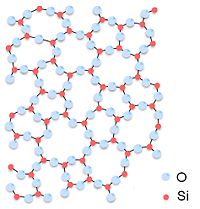A discovery published in the journal Nature helps in understanding the distortions in the movement of amorphous materials, which are solids without an orderly form that are strong as solids but lack a crystalline form, similar to liquids

Scientists from laboratories in Bordeaux, Lyon and Paris presented the first proof that amorphous materials, also known as "soft glasses", warp and flow through the cooperative movement of their particles. These materials, which also include chocolate mousse, shaving cream, mayonnaise, fiberglass and mud, are solids without an orderly form, that is, they are strong like solids but lack a crystalline form, similar to liquids.
This discovery, published in the prestigious journal Nature, will help to better understand states of deformation and breakage in fiberglass and similar materials, and the dispersion of thin layers of delicate materials (such as face creams) used in cosmetics, food products and the oil industry.
An amorphous solid is a liquid that does not flow: its atomic structure is disorganized, similar to a liquid, but rigid and retains its shape similar to a solid. Amorphous materials include silicate glass and a wide variety of other materials, such as soft glass (for example - concentrated emulsions, foams and glass suspensions). They are usually found in our kitchen as mayonnaise, chocolate mousse or ketchup - or in the bathroom in the form of various gels or creams for cosmetic care. These substances are able to flow, if forced: mayonnaise looks solid in its jar but can be spread, or actually spread, with a knife, similar to liquid honey.
The nature and origin of this amorphous state continues to pose a scientific challenge to researchers. Do these materials deform like similar crystalline solids? Or do they flow like the liquids that resemble their structure? The dual nature of these materials is extremely significant from an industrial point of view and therefore they arouse research interest.
Progress has been made on several fronts in this field in recent years. Experimental and theoretical studies on amorphous solids have enabled a better understanding of the dual nature of these rigid structures: at the atomic level, their particles move together, a fact that allows their organized structure to reach the point of complete arrangement. On the other hand, the connection to their flow behavior has not been fully understood until today.
Scientists conducted a series of experiments using "microfluidic" methods that allowed them to observe the flow of highly concentrated emulsions in microchannels with variable diameters. These materials consist of highly concentrated clusters of silicone oil droplets suspended in a liquid and allow viewing the inside of the emulsion under a microscope. This is a typical example of a material that is a soft glass: the drops are completely irregular but the emulsion does not flow unless a strong force is applied to it.
By examining the flow of this material in tubes with micrometer diameters, the researchers were able to discover that the internal flow properties of the material depend on its components, that is, the fact that it is forced to flow in a narrow channel. In some situations, surprisingly, the material is much more fluid when it is constrained by force. Careful examinations of these materials revealed that the flow movements of the particles occur in a cooperative manner (in this case, the particles are oil droplets moving in clusters). However, this cooperative outcome is very different from the one observed for the cooperative dynamics of non-flowing amorphous materials, and hence new theoretical questions arise.
This study sheds light on the flow properties of amorphous solids and should help improve the understanding of this complex phenomenon. One of the goals of this research is the desire to correctly predict the material strength characteristics of various components, including glass and fiberglass.

2 תגובות
I'm still looking for materials that can be used to make gliders for safe mobility, and to reduce the load
on the roads.
I used to think that the silica material could provide a solution for the aerodynamic engineers, and all the crazy people
talk, but I don't know what the consequences are.
It is possible if every threat of a nuclear arrow is removed from the world, and the resources will be directed towards the fun on Earth
And less for conquering the sky with indelicate forces, to say the least, we will be able to direct our dreams to a world that is easier and more refreshing.
I still dream, and believe that our children also strive for this... and time will tell.
This was the corner of my innocence, which will never lose its sputum.. I will continue to dream for you and you will come true
For good and right.
And cool, I gave you material to direct the right wave.. It seems to me that you have a good head, if we didn't spoil too much.
Meanwhile.
I'm willing to admit that economic interests are less of a concern to me, although locally inclined, but if cooperation is encouraged, the sky is indeed the limit in the guaranty allowed for a glimpse, and serves the peace
the world, and the good life for everyone.
That's it, I confessed. Bye.
We didn't know that such a problem hides behind the condition of all the everyday substances we know as creams, ointments, etc.